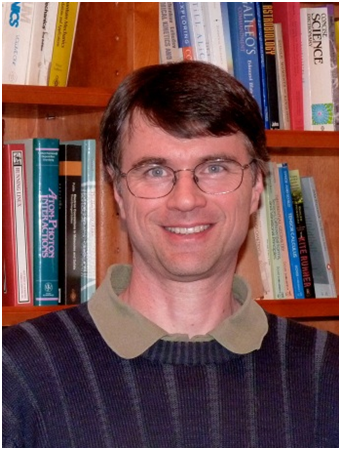Columbus, Ohio (Nov. 7, 2012) – Martin Head-Gordon, Ph.D., professor of chemistry at the University of California, Berkeley, will deliver the 2012 Pitzer Lecture in Theoretical Chemistry at 4 p.m., Wednesday, Nov. 7 in Room 2015 of McPherson Laboratory, 140 W. 18th Ave., on the main campus of The Ohio State University.
 |
| Martin Head-Gordon, Ph.D |
 |
| Russell M. Pitzer, Ph.D. |
Head-Gordon’s address is titled, “Calculating and analyzing intermolecular interactions using electronic structure theory.” The Pitzer Lecture in Theoretical Chemistry is organized and supported by the Ohio Supercomputer Center (OSC) and the Ohio State department of chemistry. Professor Susan Olesik, Ph.D. and chairperson of the Ohio State department of chemistry, will deliver the welcome, and a reception will follow the lecture in Room 2136 of Newman and Wolfrom Laboratory.
In this talk, Head-Gordon will discuss recent developments in economical electronic structure methods to calculate and then analyze intermolecular interactions. With respect to methods of calculation, density functional and wave function methods that can improve upon the accuracy of widely used standard methods will be discussed and reviewed, with an emphasis on new developments. With respect to analyzing intermolecular interactions, the basic goal is to define physically relevant components of the interaction as a variational energy decomposition analysis (EDA). Terms that may be identified this way include the interaction of frozen monomer orbitals (electrostatics and Pauli repulsion), dispersion interactions, polarization or induction, and charge transfer effects. A range of chemical examples including hydrogen-bonding in water molecules, clusters, and solvated species, as well as metal-ligand interactions will be given. Finally, some of the issues that cause controversy in the application of EDA’s will be discussed, with particular focus on the problem of distinguishing intramolecular charge transfer (i.e. monomer polarization in the EDA) from intermolecular charge transfer (i.e. charge transfer in the EDA).
Head-Gordon earned his bachelor’s and master's degrees in chemistry at Monash University in Melbourne, Australia, before coming to the United States to obtain his doctorate in theoretical chemistry at Carnegie-Mellon University, working with the late Sir John Pople on molecular orbital theory and algorithms.
From 1989-92, Head-Gordon was a postdoctoral fellow at AT&T Bell Laboratories, working with John Tully. He explored gas-surface energy exchange and developed new models for non-adiabatic energy flow. Since 1992, Head-Gordon has been on the faculty of the Chemistry Department at the University of California - Berkeley, with an additional appointment as a senior faculty scientist in the Chemical Sciences Division of Lawrence Berkeley National Laboratory. He is known for development of linear scaling methods for performing density functional theory calculations, for new methods for calculating electronic excited states, and for advances in electron correlation methods. He is one of the driving forces behind the Q-Chem quantum chemistry program.
Head-Gordon has received awards that include Packard and Sloan Fellowships, a Miller Research Professorship, and the medal of the International Academy of Quantum Molecular Sciences. He was elected to the IAQMS in 2006, to the American Academy of Arts and Sciences in 2011, and as an American Chemical Society Fellow in 2012. He is an associate editor of Molecular Physics and serves on the editorial advisory boards of Physical Chemistry Chemical Physics, the Journal of Physical Chemistry and several other journals. He has served as chair of the ACS Theoretical Chemistry Subdivision and was program chair and chair of the ACS Division of Physical Chemistry. Head-Gordon is credited with more than 300 scientific publications, over 200 invited talks and an h-index of 70.
The Pitzer Lecture in Theoretical Chemistry recognizes the many contributions of Russell M. Pitzer, Ph.D., professor emeritus of the department of chemistry at Ohio State.
Pitzer received his bachelor’s degree in chemistry from the California Institute of Technology in 1959 and his master’s degree and doctorate in chemical physics from Harvard University in 1961 and 1963, respectively. He also completed his post-doctoral fellowship at the Massachusetts Institute of Technology (MIT) in 1963. Pitzer began his teaching career at Caltech that same year, before moving to Ohio State in 1968, where he later served as chairman of the department of chemistry.
Pitzer’s doctoral thesis is considered one of the very few genuine landmarks in the history of theoretical chemistry. The pioneering research in Pitzer’s 1973 paper, “Electron Repulsion Integrals and Symmetry Adapted Charge Distributions,” enabled ab initio computations on larger molecular systems than previously possible.
In 1987, Pitzer co-founded and served as acting associate director of OSC. He also became a trustee of Pitzer College in Claremont, Calif., an institution that was founded by his grandfather, Russell K. Pitzer, and was awarded an honorary degree of Doctor of Humane Letters at Pitzer College in 2003.
_______________
The Ohio Supercomputer Center (OSC), a member of the Ohio Technology Consortium of the Ohio Board of Regents, addresses the rising computational demands of academic and industrial research communities by providing a robust shared infrastructure and proven expertise in advanced modeling, simulation and analysis. OSC empowers scientists with the vital resources essential to make extraordinary discoveries and innovations, partners with businesses and industry to leverage computational science as a competitive force in the global knowledge economy, and leads efforts to equip the workforce with the key technology skills required to secure 21st century jobs. For more, visit www.osc.edu.